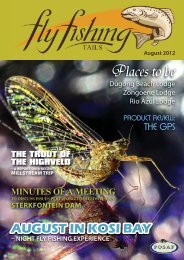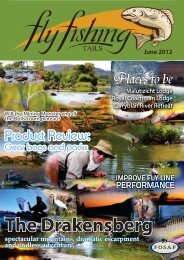MAURITIUS - Flyfishingtails
MAURITIUS - Flyfishingtails
MAURITIUS - Flyfishingtails
Create successful ePaper yourself
Turn your PDF publications into a flip-book with our unique Google optimized e-Paper software.
To fish for bass, it is important to know their habits, particularly what<br />
they eat. During the summer, bass usually spend their days and nights<br />
resting in the deeper water, but move to the shallow water to feed<br />
in the morning and evening. These areas have vegetation or other<br />
structures which attract the creatures which bass feed on. Anglers<br />
look for prime bass along rocky points and steep ridges, near floating<br />
vegetation, or in coves filled with trees.<br />
<br />
The Coho salmon was introduced to Ontario waters in the late 1800’s.<br />
In the 1960’s they were stocked in large amounts and the permanent<br />
population became established.<br />
Adults are steel-blue to slightly green on the back, gleaming silver on<br />
the sides, and white on the underbelly. There are little black spots on<br />
the back and sides right above the lateral line, on the base of the dorsal<br />
fin, and on the upper half of the caudal fin. Coho are different from<br />
the Chinook salmon and other salmon of the Ontario Great Lakes by<br />
having the inside of their teeth set in white coloured gums, their tail<br />
is slightly forked with many spots on the top half, and having 12-15<br />
rays in their anal fin.<br />
<br />
Although a large proportion reach maturity within a year, spotted<br />
bass found in spawning areas are usually three to four years old. Rock<br />
and gravel are usually chosen as suitable spawning areas at water<br />
temperatures of 57-74°F.<br />
Spotted bass seem to be segregated by habitat type from closely related<br />
species. They tend to be found in areas with more current than<br />
largemouth bass, and they usually inhabit areas that are too warm,<br />
turbid and sluggish for smallmouth bass.<br />
<br />
The Ohrid trout passes its day in depths away from shore, and it<br />
comes to the surface in the evening when it hunts flies. It sometimes<br />
come to the shore in shallow water, searching for food from underwater<br />
plants.<br />
Ohrid trout is different from spring trout because it has a flat body,<br />
small head and star like grey freckles along its body. The colour of the<br />
flash to some of them is white and to some of them is pink. The maximum<br />
length is from 25 to 60cm, and the maximum weight is 15,8kg.<br />
2012 Wild Trout Festival,<br />
21st to 24th March 2012<br />
Wednesday 21st March 2012<br />
15h00+ Arrival of participants in Rhodes<br />
17h30 Registration at Walkerbouts, arrange beats<br />
18h00 Welcome, introductions & Q&A at Walkerbouts<br />
19h30 Dinner at Walkerbouts<br />
Thursday 22nd March 2012<br />
07h00 Meet guides, go fishing<br />
19h30 Dinner<br />
Friday 23rd March 2012<br />
07h00 Meet guides, go fishing<br />
19h30 Dinner<br />
Saturday 24th March 2011<br />
07h00 Meet guides, go fishing<br />
17h00 Close of fishing for the day – wherever<br />
19h30 Dinner<br />
Sunday 25th March 2012<br />
04h00 Go fishing - go home?? (Nah, stay on for the rest<br />
of the week!)<br />
Please note:<br />
Catch returns as per example below must be completed and<br />
handed in on a daily basis.<br />
Water will be allocated each evening by Tony Kietzman.<br />
Please note that inclement weather is beyond our control & can<br />
impinge on arrangements.<br />
The event is not a competition. It is a festival and there are no<br />
prizes however, sponsored goods will be auctioned during the<br />
final dinner on the 24th.<br />
Should there be any interest in informal demonstrations and talks<br />
about fly tying, knot tying, stream tactics etc please let us know<br />
so that we can make appropriate arrangements.<br />
For non-fishing participants:<br />
Pottery classes are available for ladies who are not smitten by<br />
things piscatorial – more details to follow. In the meantime, for<br />
a brief glance at things to come, go to the limk below for a brief<br />
preview of the pottery classes and venue on offer:<br />
http://www.walkerbouts.co.za/index.php?option=com_content&view=<br />
article&id=17&Itemid=22<br />
Visits to nearby rock art sites can also be arranged.<br />
NB. The field is limited to 40 participants.







